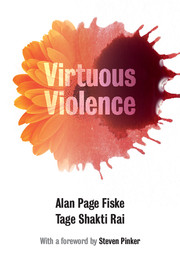Book contents
- Frontmatter
- Dedication
- Contents
- Figures and tables
- Foreword
- Warm thanks
- The point
- 1 Why are people violent?
- 2 Violence is morally motivated to regulate social relationships
- 3 Defense, punishment, and vengeance
- 4 The right and obligation of parents, police, kings, and gods to violently enforce their authority
- 5 Contests of violence: fighting for respect and solidarity
- 6 Honor and shame
- 7 War
- 8 Violence to obey, honor, and connect with the gods
- 9 On relational morality: what are its boundaries, what guides it, and how is it computed?
- 10 The prevailing wisdom
- 11 Intimate partner violence
- 12 Rape
- 13 Making them one with us: initiation, clitoridectomy, infibulation, circumcision, and castration
- 14 Torture
- 15 Homicide: he had it coming
- 16 Ethnic violence and genocide
- Chapter 17 Self-harm and suicide
- 18 Violent bereavement
- 19 Non-bodily violence: robbery
- 20 The specific form of violence for constituting each relational model
- 21 Why do people use violence to constitute their social relationships, rather than using some other medium?
- 22 Metarelational models that inhibit or provide alternatives to violence
- 23 How do we end violence?
- 24 Evolutionary, philosophical, legal, psychological, and research implications
- The dénouement
- References
- Index
2 - Violence is morally motivated to regulate social relationships
Published online by Cambridge University Press: 05 December 2014
- Frontmatter
- Dedication
- Contents
- Figures and tables
- Foreword
- Warm thanks
- The point
- 1 Why are people violent?
- 2 Violence is morally motivated to regulate social relationships
- 3 Defense, punishment, and vengeance
- 4 The right and obligation of parents, police, kings, and gods to violently enforce their authority
- 5 Contests of violence: fighting for respect and solidarity
- 6 Honor and shame
- 7 War
- 8 Violence to obey, honor, and connect with the gods
- 9 On relational morality: what are its boundaries, what guides it, and how is it computed?
- 10 The prevailing wisdom
- 11 Intimate partner violence
- 12 Rape
- 13 Making them one with us: initiation, clitoridectomy, infibulation, circumcision, and castration
- 14 Torture
- 15 Homicide: he had it coming
- 16 Ethnic violence and genocide
- Chapter 17 Self-harm and suicide
- 18 Violent bereavement
- 19 Non-bodily violence: robbery
- 20 The specific form of violence for constituting each relational model
- 21 Why do people use violence to constitute their social relationships, rather than using some other medium?
- 22 Metarelational models that inhibit or provide alternatives to violence
- 23 How do we end violence?
- 24 Evolutionary, philosophical, legal, psychological, and research implications
- The dénouement
- References
- Index
Summary
Virtuous violence theory proposes that the perpetrator intends to harm or kill in order to constitute a social relationship to make it correspond with a prescriptive model of what the relationship ought to be – what it must be made to be. For our purposes, a social relationship consists of complementarity between the actions of the participants: each participant’s actions fit previous actions by the other and presuppose “fitting” actions by the other(s), such that the actions of each are incomplete without the congruent action by the other(s). That is, the acts of each are part of a whole that none of them can bring off alone. We encompass in the terms “act” and “actions” not simply the morphology of movements, but also, crucially, the participant’s intentions, moral judgments, and motives (often consciously experienced as emotions). Furthermore, each participant implicitly or explicitly aims to induce completion of her acts: she intends to motivationally evoke and morally invoke the congruent actions that will complete or dynamically sustain the jointly constructed pattern. That is, a participant expects the other(s) to do their part, in the predictive sense, in the hopeful sense, and in the evaluative sense of judging the others’ actions according to how well they complete the intended gestalt. A football game is only football if the opposing players hit each other as hard as they can; the offense can only play offense, blocking and knocking down defenders, against a tackling defense.
Fundamental ways of relating: the four elementary relational models
Relational models theory (RMT) posits that people in all cultures coordinate nearly all aspects of most social activities by four fundamental relational models (RMs) (Fiske, 1991, 1992, 2000; Fiske and Haslam, 2005). People use these implicit, intrinsically motivated RMs to generate, understand, and evaluate interaction. The models are communal sharing (CS), authority ranking (AR), equality matching (EM), and market pricing (MP). At this point, over 275 researchers have used a great variety of methods to study many social and cognitive phenomena in diverse cultures, and have published hundreds of experimental, ethnographic, interpretive, theoretical, analytic, and philosophical papers, dissertations, and books supporting, extending, or applying RMT (www.rmt.ucla.edu). An essential aspect of these models is the four fundamental motives that underlie most moral judgment, emotions, and behavior: unity, hierarchy, equality, and proportionality (Rai and Fiske, 2011).
- Type
- Chapter
- Information
- Virtuous ViolenceHurting and Killing to Create, Sustain, End, and Honor Social Relationships, pp. 17 - 34Publisher: Cambridge University PressPrint publication year: 2014

